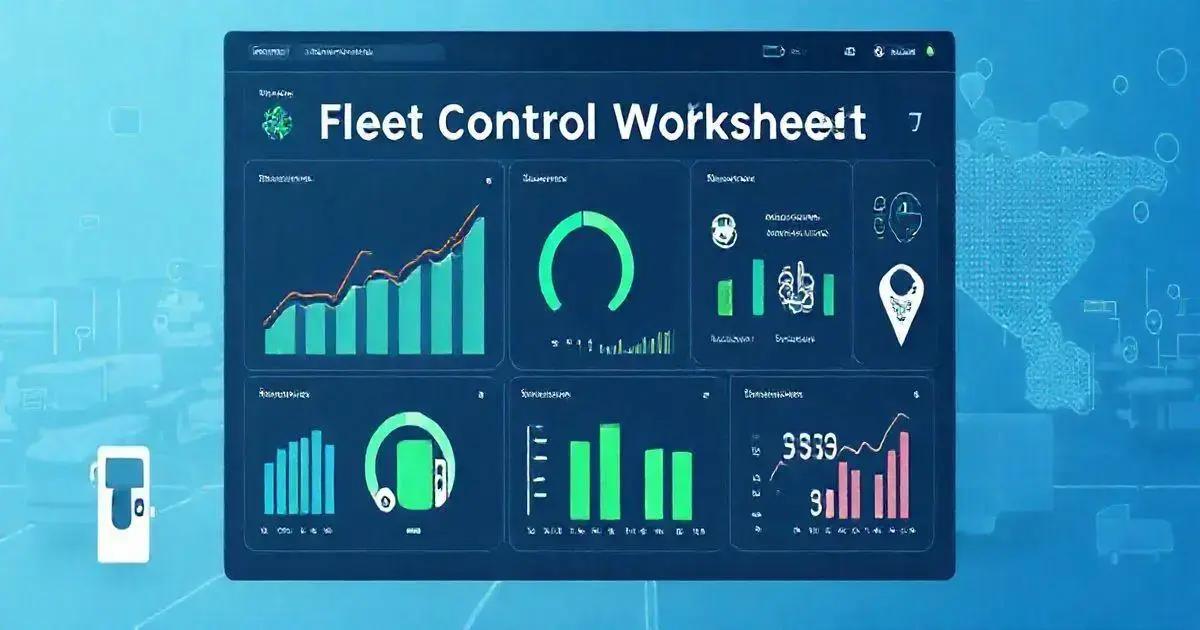Fleet Control Worksheet 7.0: Optimize Your Fleet Management Leave a comment
The Fleet Control Worksheet 7.0 is a comprehensive tool designed to optimize fleet management by facilitating organized tracking of maintenance, travel, tire control, and document management, ultimately enhancing vehicle reliability, efficiency, and cost-effectiveness for fleet managers.
The Fleet Control Worksheet 7.0 is designed to enhance your fleet management process like never before. With features that allow you to track maintenance, fuel consumption, and travel expenses, this tool is essential for any operation looking to optimize efficiency and reduce costs.
Initial Dashboards Overview
The Fleet Control Worksheet 7.0 offers an intuitive Initial Dashboard that provides a comprehensive overview of your fleet’s performance. This dashboard is designed to help fleet managers gain insights at a glance, making it easier to make informed decisions.
Key Metrics Displayed:
Key Metrics Displayed:
- KM by Driver: This metric allows you to monitor the distance each driver travels, making it easier to identify patterns and performance levels.
- KM per Vehicle: Keeping track of kilometers driven per vehicle helps in assessing utilization and pinpointing vehicles that may need attention.
- KM per Liter: This figure provides insight into fuel efficiency, highlighting vehicles that consume more fuel than expected.
- KM per Trip: Analyzing kilometers driven per trip can help optimize routes and reduce unnecessary mileage.
- Average Consumption per Vehicle: This metric averages fuel consumption across all vehicles, allowing for easier assessment of efficiency.
- Average Consumption per Driver: Monitoring average consumption by driver can identify training opportunities for fuel-efficient driving practices.
- Total General Maintenance: Tracking all maintenance activities ensures that no vehicle is left unchecked, promoting longevity and reliability.
- Maintenance Cost Average: This average cost helps in budgeting and forecasting future expenses related to fleet maintenance.
- Total Mechanical and Electrical Maintenance Costs: Understanding these costs can help prioritize which vehicles need immediate attention or replacement.
- Total Tire Maintenance Cost: Keeping track of tire costs ensures that you maintain optimal safety and performance standards.
- Total Lubricant Cost: This metric helps manage expenses related to lubricants, ensuring they align with operational budgets.
- Vehicles in Transit: Keeping an eye on vehicles currently in transit can help in resource planning.
- Tires in Transit: Similar to vehicles, tracking tire inventory that is on the move can assist in logistics management.
- Delayed Vehicle Documents: Staying updated on any documentation that is overdue ensures compliance with regulations.
- Delayed Driver Documents: Monitoring driver document status is equally crucial for compliance and safety.
- Delayed Preventive Maintenance: This feature helps you avoid costly repairs by ensuring that all preventive maintenance tasks are completed on time.
- Total Cost Versus Shipping: A comparative analysis of costs can help in evaluating the efficiency of operations.
- Fuel, Maintenance, and Other Costs: Understanding the total costs involved in fleet management can aid in budget allocation and financial forecasting.
With these metrics at your fingertips, the Initial Dashboard of the Fleet Control Worksheet 7.0 empowers you to manage your fleet more effectively, ensuring that every aspect of your operations is optimized for success.

Registration Essentials
Managing a fleet effectively begins with proper registration of essential information. The Fleet Control Worksheet 7.0 simplifies the registration process with dedicated sections for each critical element necessary for comprehensive fleet management.
Key Registration Categories:
- Driver Registration: This section allows you to input essential details for each driver, including name, contact information, license number, and any certifications. Keeping this information organized helps in managing driver assignments and ensuring compliance.
- Vehicle Type Registration: Registering different types of vehicles within your fleet is vital. This section captures details such as make, model, year, fuel type, and vehicle identification number (VIN). This ensures that you have accurate data for maintenance and operational planning.
- Mechanical and Electrical Services Registry: Maintain a detailed record of all mechanical and electrical services performed on each vehicle. This helps in tracking service history and scheduling future maintenance, thereby extending the vehicle’s lifespan.
- Tree Service Registration: If your fleet includes specialized vehicles for tree service operations, this section allows you to track their specific requirements and maintenance needs, ensuring they are always in top working condition.
- Lubricant Services Register: Keeping track of lubricant services is crucial for maintaining engine health. This section helps manage lubricant supplies and service records for each vehicle, ensuring that your fleet runs efficiently.
- Register of Workshops and Suppliers: A list of trusted workshops and suppliers is essential for quick access when maintenance or repairs are needed. This section allows for organized contact information and service rates, helping streamline the maintenance process.
- Expenditure Type Register: Categorizing expenses related to fleet management helps in budgeting and financial reporting. Track various expenditure types, from fuel costs to maintenance expenses, ensuring a comprehensive overview of fleet spending.
- Refueling Station Registration: Maintain a record of preferred refueling stations, including location, pricing, and fuel types available. This information aids drivers in finding the best refueling options while on the road.
- Fuel Type Register: Documenting the types of fuel each vehicle uses ensures proper refueling practices and compliance with environmental regulations. This section helps manage costs and optimize fuel efficiency.
By accurately capturing and organizing this essential registration information, fleet managers can streamline operations, enhance safety, and ensure compliance with all regulations. The Fleet Control Worksheet 7.0 provides intuitive fields and structured data entry, making it easy to keep your fleet in optimal condition.
Document Management Best Practices
Effective document management is crucial for maintaining a well-organized and compliant fleet operation. The Fleet Control Worksheet 7.0 includes features designed to help fleet managers manage all essential documents efficiently. Here are some best practices for document management within your fleet:
Key Document Management Practices:
- Driver Document Control: Keep track of all driver-related documents, such as licenses, certifications, and medical reports. Use the worksheet to set reminders for document renewals, ensuring that all drivers are compliant with local regulations.
- Vehicle Document Control: Maintain a comprehensive record of each vehicle’s documents, including registration, insurance, and inspection certificates. This section helps you schedule timely renewals and avoid penalties.
- Digital Storage of Documents: Whenever possible, digitize important documents to reduce physical storage needs and enhance accessibility. Use scanned copies or digital forms and store them securely in the worksheet for easy retrieval.
- Regular Audits: Conduct regular audits of your document management system to ensure that all documents are current and in proper order. This proactive approach helps identify missing or outdated documents before they become a compliance issue.
- Centralized Document Repository: Create a centralized repository for all fleet documents, ensuring that every team member has access to the most up-to-date information. The Fleet Control Worksheet 7.0 allows for structured organization so that documents are easy to find and manage.
- Set Document Management Policies: Establish clear policies outlining how documents should be handled, stored, and disposed of. Communicate these policies to your team to ensure everyone understands their responsibilities regarding document management.
- Training and Awareness: Provide training for your team on best practices for document management. Regularly update staff on any changes to policies or procedures to maintain high standards of compliance.
- Backup Important Documents: Regularly back up important documents to prevent loss due to technical failures or disasters. Use cloud storage solutions to ensure that your documents are safe and accessible from anywhere.
- Monitor Document Expiration: Use the worksheet to track the expiration dates of essential documents, such as insurance and registrations. Implement alerts to notify relevant personnel ahead of time, allowing for a smooth renewal process.
By adhering to these best practices for document management, you can ensure that your fleet operates smoothly and complies with all legal requirements. The Fleet Control Worksheet 7.0 serves as a valuable tool for maintaining organized documentation, enabling you to focus on optimizing your fleet’s performance.

Travel Management Simplified
Travel management is a key aspect of fleet operations, and the Fleet Control Worksheet 7.0 simplifies this process significantly. With comprehensive features designed to handle every step of your fleet’s travel logistics, managing trips becomes more efficient and organized.
Essential Components of Travel Management:
Essential Components of Travel Management:
- Cargo Control Linked to Trips: This feature allows you to associate specific cargo loads with their respective trips. By tracking what is being transported, you can ensure accountability and streamline logistics.
- Vehicle Control: Monitor which vehicles are assigned to each trip, helping you manage usage efficiently. Assigning vehicles accurately can reduce wear and tear and ensure that each vehicle is utilized appropriately based on its capacity and functionality.
- Driver Control: Link drivers to specific trips to enhance accountability and track performance. This feature allows for better management of driver schedules and can help in identifying training needs based on trip outcomes.
- Supply Control: Managing supplies required for each trip is crucial. Use the worksheet to keep track of fuel, maintenance supplies, and any other essentials that your drivers may need while on the road, ensuring they are always prepared.
- Control of All Travel Expenses: Keep detailed records of all expenses related to each trip, including fuel costs, tolls, and maintenance. This section helps in budgeting and financial planning, allowing fleet managers to identify areas for cost reduction.
- Trip Scheduling: Utilize the scheduling feature to plan trips ahead of time, ensuring optimal route selection and resource allocation. This proactive approach helps in avoiding conflicts and ensuring timely deliveries.
- Analyze Trip Data: Use the worksheet to analyze travel data over time. Understanding patterns in travel can lead to improvements in logistics and efficiency, as well as uncovering insights into fuel consumption and cost management.
- Feedback Loop: Implement a system for drivers to provide feedback on their trips. This can cover road conditions, vehicle performance, and operational challenges faced during travel. Gathering feedback helps improve future travel management strategies.
With these features, the Fleet Control Worksheet 7.0 makes travel management a straightforward and organized process. By simplifying the complexities associated with fleet travel, fleet managers can focus on enhancing operational efficiency and improving service quality.
Tire Control Techniques
Effective tire management is crucial for the safety and efficiency of your fleet. The Fleet Control Worksheet 7.0 provides comprehensive features for tracking and managing your tires, ensuring that your fleet operates smoothly and safely.
Key Tire Control Techniques:
- Identification for Each Tire: Maintain a detailed record for each tire, including its make, model, purchase date, and serial number. This information helps you track the history and performance of each tire, enabling informed decisions on replacements and rotations.
- Regular Inspection Schedule: Implement a systematic inspection routine to check tire pressure, tread depth, and overall condition. Regular inspections can identify potential issues before they become serious, extending the life of your tires and enhancing safety.
- Pressure Monitoring: Keep tires properly inflated to optimize fuel efficiency and tire performance. Use tire pressure monitoring systems (TPMS) to receive alerts when pressure falls below recommended levels, helping to prevent blowouts and uneven wear.
- Tread Depth Management: Monitor tread depth using gauges to ensure tires have adequate grip and performance. Keeping an eye on tread depth can prevent hydroplaning and enhance handling, particularly in adverse weather conditions.
- Rotation and Alignment: Schedule regular tire rotations and alignments to ensure even wear across all tires. This practice not only prolongs the lifespan of your tires but also improves fuel efficiency and vehicle handling.
- Tracking Tire Costs: Maintain a record of all expenses related to tire purchases, maintenance, and replacements. This helps in budgeting and can uncover patterns in tire wear that may indicate deeper issues within the fleet.
- Emergency Procedures: Develop guidelines for dealing with tire blowouts or punctures. Train your drivers on how to handle these situations safely and efficiently, minimizing downtime and ensuring safety on the road.
- Utilizing Technology: Implement tire management software or apps that sync with your Fleet Control Worksheet. These tools can provide insights into tire performance and automate reminders for inspections and replacements.
By applying these tire control techniques, fleet managers can ensure optimal tire performance, improve safety, and ultimately reduce costs associated with tire maintenance and replacement. Utilizing the features of the Fleet Control Worksheet 7.0 streamlines tire management, allowing you to focus on your fleet’s operational efficiency.

Maintenance Control Strategies
Implementing effective maintenance control strategies is essential for ensuring the longevity and reliability of your fleet. The Fleet Control Worksheet 7.0 assists fleet managers in organizing and scheduling maintenance tasks, maximizing vehicle performance while minimizing downtime.
Key Maintenance Control Strategies:
- Preventive Maintenance Scheduling: Establish a preventive maintenance schedule based on manufacturer recommendations and operational usage. This proactive approach helps in identifying potential issues before they escalate and ensures that all vehicles receive timely servicing.
- Tracking Maintenance History: Maintain detailed records of all maintenance activities performed on each vehicle. This history allows you to analyze trends, identify recurring issues, and plan future maintenance more effectively.
- Regular Inspections: Conduct regular inspections on all vehicles to assess their condition and perform necessary adjustments or repairs. Inspections can include checks on brakes, fluids, tires, and other critical components to ensure safety and reliability.
- Utilization of Checklists: Use maintenance checklists to ensure all tasks are completed during inspections and servicing. This method helps in standardizing processes and reduces the chance of oversight, ensuring comprehensive vehicle care.
- Predictive Maintenance: Incorporate predictive maintenance techniques using diagnostic tools to monitor vehicle performance and identify potential failures. This method leverages data analytics to inform maintenance decisions, allowing for targeted interventions before breakdowns occur.
- Cost Management: Track all maintenance-related expenses, including parts, labor, and service fees. Analyzing these costs helps in budgeting and identifying areas where you can reduce expenses while maintaining performance standards.
- Training for Staff: Ensure that your maintenance personnel are well-trained in the latest maintenance practices and technologies. Continuous education can lead to higher efficiency and safety standards within your fleet operations.
- Utilizing Maintenance Software: Implement maintenance management software to streamline scheduling, tracking, and reporting. This technology can automate reminders for upcoming tasks and provide valuable insights into fleet performance, ultimately improving overall efficiency.
- Establishing Key Performance Indicators (KPIs): Define KPIs to measure the effectiveness of your maintenance strategies, such as vehicle downtime, maintenance costs per mile, and adherence to schedules. Regularly review these metrics to identify areas for improvement.
By applying these maintenance control strategies, fleet managers can ensure their vehicles remain in peak condition, leading to increased operational efficiency and reduced costs associated with unexpected repairs and downtime. The Fleet Control Worksheet 7.0 is a valuable tool in achieving these objectives, enabling you to focus on what matters most: keeping your fleet on the road.
Conclusion
In summary, the Fleet Control Worksheet 7.0 is an essential tool for fleet managers seeking to enhance the efficiency and effectiveness of their operations.
By focusing on key areas such as travel management, tire control, and maintenance control strategies, fleet managers can ensure that their vehicles are well-maintained, safe, and cost-effective.
Implementing the best practices outlined in this guide will lead to improved performance, reduced downtime, and significant cost savings.
The organization and insights provided by the worksheet not only streamline the day-to-day management of your fleet but also contribute to long-term success.
Investing in a structured approach to fleet management with the Fleet Control Worksheet 7.0 will empower your team to make informed decisions, optimize resources, and ultimately drive your fleet towards greater heights.
FAQ – Frequently Asked Questions about Fleet Control Worksheet 7.0
What is the Fleet Control Worksheet 7.0?
The Fleet Control Worksheet 7.0 is a comprehensive tool designed to help fleet managers efficiently track and manage various aspects of fleet operations, including vehicle maintenance, travel management, and tire control.
How can the worksheet improve maintenance control?
The worksheet allows fleet managers to schedule preventive maintenance, track maintenance histories, and use checklists to ensure comprehensive vehicle care, ultimately improving reliability and reducing downtime.
What features does the travel management section include?
The travel management section includes cargo control linked to trips, vehicle and driver management, supply control, and a comprehensive overview of all travel expenses.
Is it easy to track tire performance and maintenance?
Yes, the worksheet provides features for identifying each tire, scheduling regular inspections, monitoring tire pressure, and tracking costs associated with tire maintenance.
Can I customize the worksheet to fit my fleet’s specific needs?
The Fleet Control Worksheet 7.0 is designed to be flexible, allowing for customization to meet the unique requirements of your fleet operations.
How does the worksheet help in cost management?
It allows fleet managers to keep detailed records of all expenses related to vehicles, maintenance, and travel, helping to identify areas for cost reduction and optimize budgeting.

